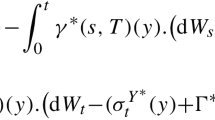Abstract
The rate of return of a zero-coupon bond with maturity T is determined by our expectations about the mean (+), variance (-) and skewness (+) of the growth of aggregate consumption between 0 and T. The shape of the yield curve is thus determined by how these moments vary with T. We first examine growth processes in which a higher past economic growth yields a first-degree dominant shift in the distribution of the future economic growth, as assumed for example by Vasicek (J. Financ. Econ. 5, 177–188, 1977). We show that when the growth process exhibits such a positive serial dependence, then the yield curve is decreasing if the representative agent is prudent (\(u^{\prime \prime \prime } > 0\)), because of the increased risk that it yields for the distant future. A similar definition is proposed for the concept of second-degree stochastic dependence, as observed for example in the Cox–Ingersoll–Ross model, with the opposite comparative static property holding under temperance (\(u^{\prime \prime \prime \prime } < 0\)), because the change in downside risk (or skweness) that it generates. Finally, using these theoretical results, we propose two arguments in favor of using a smaller rate to discount cash-flows with very large maturities, as those associated to global warming or nuclear waste management.
Similar content being viewed by others
References
Arrow, K.J., Cline, W.R., Maler, K.-G., Munasinghe, M., Squitieri, R., Stiglitz, J.E.: Intertemporal equity, discounting and economic efficiency. In: Bruce, J.P., Lee, H., Haites, E.F. (eds.) Climate Change 1995—Economic and Social Dimensions of Climate Change. Cambridge University Press, Cambridge, (1996)
Backus, D., Foresi, S., Telmer, C.: Discrete-time models of bond pricing, NBER Working Paper 6736 (1998)
Barsky R.B. (1989). Why don’t the prices of stocks and bonds move together?. Am. Econ. Rev. 79: 1132–1145
Campbell (1986). Bond and stock returns in a simple exchange model. Q. J. Econ. 101: 785–804
Cochrane J.H. (1988). How big is the random walk in GNP?. J. Polit. Econ. 96: 893–920
Cochrane, J.: Asset Pricing. Princeton University Press (2001)
Cogley T. (1990). International evidence on the size of the random walk in output. J. Polit. Econ. 98: 501–518
Cox J., Ingersoll J., Ross S. (1985). A theory of the term structure of interest rates. Econometrica 53: 385–403
Cox J., Ingersoll J., Ross S. (1985). An intertemporal general equilibrium model of asset prices. Econometrica 53: 363–384
Breeden D.T. (1986). Consumption, production, inflation and interest rates: a synthesis. J. Financ. Econ. 16: 3–40
DeLong, B.J.: Chapter 5: the reality of economic growth: history and prospect. http://www.j-bradford-delong.net (2004)
Eeckhoudt L., Gollier C., Schneider T. (1995). Risk aversion, prudence and temperance: a unified approach. Econ. Lett. 48: 331–336
Estrella A., Hardouvelis G.A. (1991). The term structure as a predictor of real economic activity. J. Financ. 46: 555–576
Geiss C., Menezes C., Tressler J. (1980). Increasing downside risk. Am. Econ. Rev. 70(5): 921–931
Gollier C. (2002). Discounting an uncertain future. J. Public Econ. 85: 149–166
Gollier C. (2002). Time horizon and the discount rate. J. Econ. Theory 107: 463–473
Gollier C., Pratt J.W. (1996). Risk vulnerability and the tempering effect of background risk. Econometrica 64: 1109–1124
Groom, B., Koundouri, P., Panopoulou, E., Pantelidis, T.: Model selection for estimating certainty equivalent discount, mimeo, UCL, London (2004)
Hansen L., Singleton K. (1983). Stochastic consumption, risk aversion and the temporal behavior of assets returns. J. Polit. Econ. 91: 249–265
Joe, H.: Multivariate models and dependence concepts. Chapman and Hall/CRC (1997)
Kimball M.S. (1990). Precautionary savings in the small and in the large. Econometrica 58: 53–73
Kocherlakota N.R. (1996). The equity premium: it’s still a puzzle. J. Econ. Lit. 34: 42–71
Lehmann E.L. (1966). Some concepts of dependence. Ann. Math. Statist. 37: 1137–1153
Leland H. (1968). Savings and uncertainty: the precautionary demand for savings. Q. J. Econ. 45: 621–36
Lucas R. (1978). Asset prices in an exchange economy. Econometrica 46: 1429–1446
Maddison, A.: Phases of Economic Development. Oxford Economic Press (1991)
Mankiw G. (1981). The permanent income hypothesis and the real interest rate. Econ. Lett. 7: 307–311
Milgrom P. (1981). Good news and bad news: representation theorems and applications. Bell J. Econ. 12: 380–391
Newell R., Pizer W. (2003). Discounting the benefits of climate change mitigation: How much uncertain rates increase valuations?. J. Environ. Econ. Manage. 46(1): 52–71
Piazzesi, M.: Affine term structure models. In: Ait-Sahalia, Y., Hansen, L.P. (eds) Handbook of Financial Econometrics. Elsevier (2005)
Portney, P.R., Weynant, J.P. (eds.) Discounting and intergenerational equity. Resources for the future, Washington, D.C. (1999)
Rothschild M., Stiglitz J. (1970). Increasing risk: I. A definition. J. Econ. Theory 2: 225–243
Shaked, M., Shanthikumar, J.G.: Stochastic orders. Springer series in statistics (2007)
Tchen A.H. (1980). Inequalities for distributions with given marginals. Ann. Probab. 8: 814–827
Vasicek O. (1977). An equilibrium characterization of the term structure. J. Financ. Econ. 5: 177–188
Weitzman M.L. (1998). Why the far-distant future should be discounted at its lowest possible rate?. J. Environ. Econ. Manage. 36: 201–208
Weitzman M.L. (2001). Gamma discounting. Am. Econ. Rev. 91: 260–271
Weitzman, M.L.: Statistical discounting of an uncertain distant future. Harvard University, mimeo (2004)
Author information
Authors and Affiliations
Corresponding author
Additional information
An earlier version of this paper was entitled “Transitory shocks to GNP and the consumption-based term structure of interest rates”. I am indebted to John Campbell, Martin Weitzman and to two referees for helpful comments.
Rights and permissions
About this article
Cite this article
Gollier, C. The consumption-based determinants of the term structure of discount rates. Math Finan Econ 1, 81–101 (2007). https://doi.org/10.1007/s11579-007-0004-0
Received:
Accepted:
Published:
Issue Date:
DOI: https://doi.org/10.1007/s11579-007-0004-0




